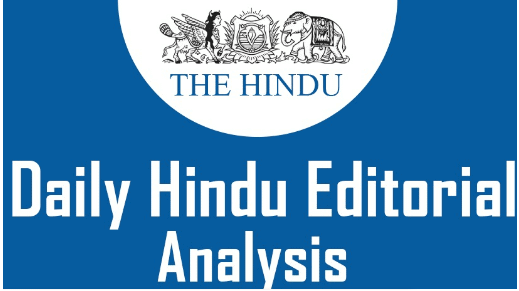CLAT Exam > CLAT Notes > Current Affairs: Daily, Weekly & Monthly > The Hindu Editorial Analysis- 1st January, 2022
The Hindu Editorial Analysis- 1st January, 2022 | Current Affairs: Daily, Weekly & Monthly - CLAT PDF Download

Needless Provocation: India, China must Adhere to Past Agreements to keep the Peace Along the Border
GS 2- IR
Context: China's Ministry of Civil Affairs announced Wednesday that it had standardised in Chinese characters, and the Tibetan and Roman alphabet, the names of 15 places in Zangnan, the Chinese name for Arunachal Pradesh, the state-run Global Times reported.
- This is a part of its strategy to reiterate territorial claims with India.
- In the past, Beijing has always objected to visits by Indian leaders – Presidents, Prime Ministers and senior ministers – to the north-eastern state. In recent months, there are reports of China establishing villages along the Line of Actual Control.
- The naming is part of the country’s aggressive expansionist approach.
- The move is ostensibly aimed at “standardising” how places in the Indian State are depicted in official Chinese maps, which show all of Arunachal as “south Tibet”.
- For the first time: The list on this occasion is longer, and not only includes eight towns but also four mountains, two rivers and a mountain pass. The list covers 11 out of Arunachal’s 25 districts, extending from Tawang in the west to Dibang Valley in the north and Anjaw in the east.
- The announcement this week came as India and China remain engaged at both diplomatic and military levels to complete the stalled disengagement process along the LAC.
Indian Response
- India’s Ministry of External Affairs (MEA) said in a statement in response to the move that “assigning invented names” will not “alter” any facts on the ground and Arunachal’s status as an integral part of India.
- As the MEA noted, this is not the first time that Beijing has done so. In 2017, Chinese authorities issued “official” names for six places in Arunachal. The first instance followed a visit by the Dalai Lama to the State, which Beijing had protested.
- If the latest move is largely symbolic and will not, as the MEA observed, change facts on the ground, it needs to be seen against the backdrop of broader changes in China’s approach to the boundary dispute.
The Chinese Strategy
- The naming announcement was made ahead of a new border law coming into force on January 1, 2022. The law, which was proposed in March 2021 and calls for various Chinese government bodies to take steps to “safeguard” Chinese territory, was put forward a year into the crisis along the Line of Actual Control (LAC).
- The spread of the locations suggests the places were chosen to reiterate Chinese claims to the whole State.
- New Delhi, which has expressed concern about the law, has seen it as an attempt to formalise the transgressions made by the Chinese military since the summer of 2020 and put a stamp on China’s unilateral measures to redraw the LAC.
- The Chinese Foreign Ministry defended the latest move saying the matter was “within China’s sovereignty”.
Conclusion
Restoring relations, as well as the status quo along the borders, will require mutual sensitivity and an adherence to past agreements that helped keep the peace, rather than needless provocations that expand an already long list of differences.
The document The Hindu Editorial Analysis- 1st January, 2022 | Current Affairs: Daily, Weekly & Monthly - CLAT is a part of the CLAT Course Current Affairs: Daily, Weekly & Monthly.
All you need of CLAT at this link: CLAT
|
831 docs|605 tests
|
FAQs on The Hindu Editorial Analysis- 1st January, 2022 - Current Affairs: Daily, Weekly & Monthly - CLAT
| 1. What is the significance of adhering to past agreements between India and China along the border? |  |
Ans. Adhering to past agreements is important to maintain peace along the border between India and China. By following these agreements, both countries can avoid unnecessary tensions and conflicts, ensuring stability in the region.
| 2. What are the potential consequences of needless provocation between India and China along the border? |  |
Ans. Needless provocation between India and China along the border can lead to escalating tensions, increased military presence, and even armed conflicts. This can disrupt the peace and stability in the region and have wider implications for bilateral relations between the two countries.
| 3. How can adhering to past agreements help in resolving border disputes between India and China? |  |
Ans. Adhering to past agreements can serve as a foundation for resolving border disputes between India and China. By honoring these agreements, both countries can engage in peaceful negotiations and diplomatic dialogues to find mutually acceptable solutions to their territorial disagreements.
| 4. What challenges may arise in the implementation of past agreements between India and China along the border? |  |
Ans. Implementing past agreements between India and China along the border may face challenges such as differing interpretations of the agreements, lack of trust between the two countries, and domestic political pressures. These challenges can hinder the smooth implementation of the agreements and require careful diplomacy to overcome.
| 5. How can India and China ensure the effective implementation of past agreements and maintain peace along the border? |  |
Ans. India and China can ensure effective implementation of past agreements and maintain peace along the border by promoting transparency, enhancing communication channels, and addressing any violations promptly through diplomatic means. Confidence-building measures and regular engagement between the two countries' military and diplomatic officials can also contribute to peaceful resolution of disputes.

|
Explore Courses for CLAT exam
|

|
Signup for Free!
Signup to see your scores go up within 7 days! Learn & Practice with 1000+ FREE Notes, Videos & Tests.
Related Searches

















